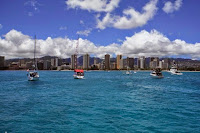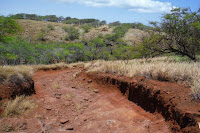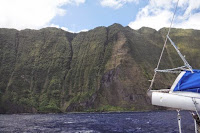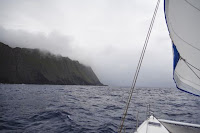




'Iolani Palace - home of the last Hawaiian Royals before they were quite illegally and unreasonably overthrown by the American military in support of American commerce (not such a proud piece of American history!)
The palace was stunning. Both monarchs had really embraced European-style royal opulence on which they modeled their positions and it was apparent in every corner. Most impressive to me was the magnificent Throne Room.
Afterwards, we walked over to Chinatown. Chinatown in Honolulu seems less well defined than in other places. It seemed more of an Asiantown with ragged edges. A highlight was the Lei making district, where tiny shop fronts are home to crowds of ladies making leis (those beautiful flower garlands) so unmistakeably Hawaiian. There were several Chinese groceries, but other than that, most of the businesses were Filipino or Thai, with the occasional Italian or French restaurant.




Honolulu's China town - Home to Wo-Fat (remember Hawaii Five-O?) among the classic Chinese stores and you can find almost anything (including Leis and chicken feet - just in case you were feeling peckish)
We were hungry and looked in vain for a Chinese restaurant before finally buying an especially delicious Thai lunch at a big food court, once refuelled, we headed out to the Foster Botanical Gardens nearby. There, we found a serene, park-like setting amongst a great collection of giant trees, including my new favorite, the Painted Gum. {Maryanne: There was such a variety of fruits and spices, just so many amazing plants in the Gardens. Including tiny 100 year old palm trees and giant fruits, coffee, black pepper and beautiful flowers....}



We made our way back home by heading back through Chinatown to the waterfront. Chinatown is not really the best area, but the part of Honolulu between there and the Ala Wai is distinctly worse. We ended up getting through okay. It was broad daylight, though. I would be pretty scared to go there at night. Its a little grubby and with a very large homeless population, often with shanty homes set up in the parks and even on the sidewalks; there is also quite a bit of very obvious prostitution of various types (more skanky than pretty; quite eye opening!).
It turns out the Ala Wai sits right at the border between the nice and not-so-nice parts of town. There are all sorts of stories going around about how dangerous and run-down it is. We have seen a hint of that here and there, but overall it seems fine, we've witnessed no threatening behaviour towards us or other passers by. Begonia is on a nice new floating dock and we haven’t had any problems with security or felt unsafe. We have certainly been worse places. It’s a big place, though and some of the other areas seem a little sketchier.




No visit to Honolulu can be considered complete without a trip to the top of the 'Aloha Tower' where we bump into (yet again) the luxury Mega-Yacht "A". After enjoying the views from atop, the walk home via the Magic Island beaches was tempered with rain, but also provided another Hawaiian rainbow for us to enjoy back at the marina




































